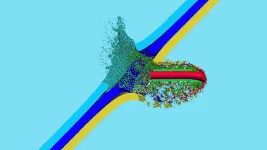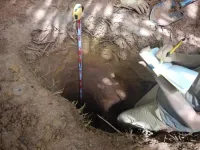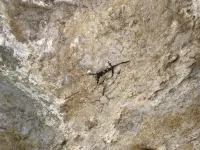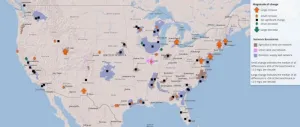(Press-News.org) Depression and anxiety among college students is a growing public health problem. And new research from the University of Georgia suggests the problem may be worse for students who aren’t the same race as most of their peers.
The new study found that students who were not the majority race at a predominantly white college reported significantly higher rates of depression than their white peers.
At the mostly white university, more than half of the students who self-identified as races other than white reported feelings of mild depression. An additional 17% said they were experiencing moderate to severe depression.
Students at the predominantly white institution all reported similar levels of anxiety, regardless of race, with more than three in every five students saying they experience mild to severe levels of anxiety.
At the historically Black college, students who weren’t Black experienced higher rates of anxiety and depression as well.
“Our study adds to the evidence of how important the work around inclusivity and mental health is in the college environment,” said Janani Rajbhandari-Thapa, an associate professor in UGA’s College of Public Health. “It’s important to be mindful that not all students come with the same background, and we need to support them more.”
First-generation students more likely to suffer depression
More than 3,100 students participated in the study during the COVID-19 pandemic, answering questions about feelings of hopelessness, sleep issues and lack of energy, among other topics.
The researchers found that first-generation students were also significantly more likely to experience depression compared to students who weren’t the first to attend college in their families.
All first-generation students surveyed expressed that they had some level of depression, regardless of the institution. Most reported mild symptoms, but more than half at the predominantly white university said they had moderate to severe levels of depression.
“I was an international student myself and can relate to the stresses of settling in during the first semester in the U.S. a little bit” Rajbhandari-Thapa said. “Being a first-generation student and experiencing college for the first time in your family comes with its own set of challenges and opportunities, and it is important that university faculty and staff work towards addressing the challenges.
“There are trainings and workshops in the workplace, but we need to do more to help new college students feel at home.”
Socializing, sense of belonging helps safeguard against mental illness
The COVID-19 pandemic disrupted daily life for most Americans. College students were particularly hard hit.
Where they would normally be socializing and engaging in group activities, many were masked up and socially distanced, preventing some of that integral interaction that strengthens social bonds. The additional stressors likely led to increases in stress and anxiety, but the researchers suggest that not all groups were affected equally.
Female students, for example, were harder hit with depression and anxiety than their male counterparts, which reflects the larger social pattern of mental health problems hitting women more intensely.
But the researchers say investing in diversity, equity, and inclusion resources can help students feel more at home on campus, regardless of their race or first-generation status.
“Belonging is so important,” Rajbhandari-Thapa said. “I don’t think there is ever enough support for first-generation and minority students. Universities are starting to do this already, but it’s important that we provide as much support as possible.”
Published by the Journal of American College Health, the study was co-authored by Kathryn Chiang, Mitchell Chen Lee, Arial Treankler and Heather Padilla, of the University of Georgia. Additional co-authors include Drs. Emily Anne Vall at Resilient Georgia and Marion Ross Fedrick at the Albany State University.
END
Depression, anxiety common among college students
Study underscores role of building culture of belonging for minority
2023-10-17
ELSE PRESS RELEASES FROM THIS DATE:
Research finds water quality in Gulf of Mexico improves when adding social costs to carbon emissions
2023-10-17
DURHAM, N.H.—U.S. Climate policies can offer options for putting climate change efforts into place that solve environmental problems like excessive carbon dioxide in the atmosphere created by greenhouse gas emissions. Research led by the University of New Hampshire took a closer look at what would happen to agriculture if there was an extra cost, or so-called social cost, added to fossil fuels, which are essential for making fertilizer used in farming. They found that while CO2 emissions would decline by as much as 50%, the cost of fertilizer would rise leading to a significant benefit on water quality by lessening fertilizer runoff contributing ...
Mitigating electrode-level heterogeneity using phosphorus nanolayers on graphite for fast-charging batteries
2023-10-17
In a major stride towards achieving fast-charging lithium-ion batteries (LIBs) with reliable cyclability, researchers at UNIST have made a groundbreaking discovery. Their study, published in the prestigious ACS Energy Letters, introduces a novel strategy of utilizing phosphorus nanolayers to enhance the lithiation kinetics and performance of graphite-based composites, without compromising safety.
Led by Professor Hyun-Wook Lee from the School of Energy and Chemical Engineering at UNIST, the research team developed a revolutionary graphite-phosphorus composite using a vaporization-condensation ...
In 2020, 30% of the Pantanal was burned to cinders by wildfires
2023-10-17
In 2020, the Pantanal, the largest tropical freshwater wetland in the world and a biodiversity hotspot, was swept by high-intensity fires that destroyed native vegetation in an area totaling 44,998 square kilometers (km²), or about 30% of the Brazilian portion of the biome, which spans some 150,000 km². The estimate is presented in an article published in the science journal Fire.
The area destroyed by that year’s disastrous fires was far larger than had been thought, according to the article. ...
SwRI will advance impact modeling software for U.S. Army Corps of Engineers
2023-10-17
SAN ANTONIO — October 17, 2023 —Southwest Research Institute (SwRI) will continue advancing the Elastic Plastic Impact Computations (EPIC) dynamic finite-element code as part of an Other Transaction Prototype Agreement with the U.S Army Corps of Engineers. The first year’s funding of $500,000 has been awarded, with optional additional funding across the next three years totaling $3.5 million.
“EPIC uses finite element and particle methods to simulate complex impact and explosion scenarios,” said SwRI Staff Engineer Dr. Stephen Beissel, who leads the EPIC project and has been involved in EPIC’s development since the mid-1990s. ...
The earthworm effect: unraveling soil weathering dynamics
2023-10-17
17 October 2023
The Geological Society of America
Release No. 23-42
Contact: Justin Samuel
+1-303-357-1026
jsamuel@geosociety.org
For Immediate Release
Contributed by Sarah Derouin
Pittsburgh, Pa., USA: Earthworms, the hardworking invertebrates that grace the upper layers of soil, have long been considered helpful in our home gardens. Earthworms are prolific munchers, grinding up organic material and sediment grains that make up soils. Although they are very different animals, worms, like many poultry, have gizzards. “Worms will ingest some larger soil grains, and then they use the strongest and largest of those grains, retaining them in their gizzard,” ...
New dating of cave art reveals history of Puerto Rican people
2023-10-17
17 October 2023
The Geological Society of America
Release No. 23-40
Contact: Justin Samuel
+1-303-357-1026
jsamuel@geosociety.org
For Immediate Release
Leer en español.
Contributed by Sarah Derouin
Pittsburgh, Pa., USA: In the karstic caves of Puerto Rico, cave art paints the rock walls. Previous research has assigned ages to this art based on the ages of nearby archaeological artifacts within the caves, but these ages are relative and may not reflect the true timing of the art creation.
Now, a new study to be presented Wednesday at the Geological Society of America’s GSA Connects 2023 meeting shows that researchers have refined the age of this rupestrian ...
U.S. groundwater is getting saltier—what that means for infrastructure, ecosystems, and human health
2023-10-17
17 October 2023
The Geological Society of America
Release No. 23-41
Contact: Justin Samuel
+1-303-357-1026
jsamuel@geosociety.org
For Immediate Release
Contributed by Sarah Derouin
Pittsburgh, Pa., USA: Scientists from the U.S. Geological Survey (USGS) have been monitoring groundwater quality in wells across the country for more than three decades, looking for harmful chemicals or residual substances that may cause harm to ecosystems or humans. In all, they have measured up to 500 chemical constituents, including major ions, metals, pesticides, volatile organic compounds, fertilizers, and radionuclides.
Of ...
Pathogen that plagues food processing plants eradicated by blue light
2023-10-17
Washington, D.C. – Blue light kills both dried cells and biofilms of the pathogen Listeria monocytogenes, a frequent contaminant of food processing facilities. Demise of L. monocytogenes occurred quickest when cells or biofilms were placed on polystyrene, a widely used, transparent form of plastic. The research is published in Applied and Environmental Microbiology, a journal of the American Society for Microbiology.
“These results contribute to advancing our understanding of the potential of blue light to treat inert surfaces contaminated with L. monocytogenes,” said corresponding author ...
Public health interventions prevented transmission within BU most SARS-CoV-2 cases
2023-10-17
(Boston)— SARS-CoV-2, the causative agent of COVID-19, began impacting the U.S. in March 2020 with many schools and universities shifting to remote education by early April 2020 in response to the public health emergency. Despite public health interventions (increased ventilation, masking policies, surveillance testing, contact tracing of confirmed cases and quarantine procedures for infected students, faculty and staff) there were still concerns that institutes of higher education would be a hotbed of transmission, including transmission from students into surrounding communities.
But, were these fears warranted?
A ...
CastleVax Inc. receives BARDA project NextGen award valued at up to $338 million to advance intranasal NDV-based COVID-19 booster vaccine into phase 2b clinical efficacy testing
2023-10-17
CastleVax, a clinical stage vaccine platform company, has received a Project NexGen award valued at up to $338 million from the Biomedical Advanced Research and Development Authority (BARDA), part of the Administration for Strategic Preparedness and Response (ASPR) in the U.S. Department of Health and Human Services (HHS), to support the development of a next-generation, booster vaccine to protect against COVID-19 for years to come. The initial phase of the award provides approximately $8.5 million to plan a Phase 2b clinical trial that would compare CastleVax’s vaccine to currently ...
LAST 30 PRESS RELEASES:
School meals could unlock major gains for human and planetary health
Menopause hormone therapy does not appear to impact dementia risk
Signature patterns of brain activity may help predict recovery from traumatic brain injury
Dresden study uncovers new key mechanism in cancer cells
New species are now being discovered faster than ever before, study suggests
Cannabis-based products show limited short-term benefit for chronic pain, with increased risk of adverse effects
Cannabis products with more THC slightly reduce pain but cause more side effects
Clearing the brain of aging cells could aid epilepsy and reduce seizures
Brain injuries linked with potential risk of suicide, new study finds
New technique lights up where drugs go in the body, cell by cell
New study finds movement of fishing fleets can reveal shifts in marine ecosystems
Embargoed: New evidence points to potential treatment for vascular dementia
Study uncovers disrupted brain balance in alcohol dependence
Working in groups can help Republicans and Democrats agree on controversial content moderation online
Structural findings reveal how distinct GPCR ligands create different levels of activation
Anything-goes “anyons” may be at the root of surprising quantum experiments
UC review: Maximizing workplace opportunity for veterans
From generation to complex control: Metasurfaces make perfect vortex beams "within reach"
Thin-film lithium niobate-based detector: recent advances and perspectives
Exploring why some people may tend to persistently make bad choices
How cells balance their protein levels
Nirsevimab vs RSVpreF vaccine for RSV–related hospitalization in newborns
Effectiveness and impact of maternal RSV immunization and nirsevimab on medically attended RSV in US children
AI gives scientists a boost, but at the cost of too many mediocre papers
Next-generation vision model maps tree growth at sub-meter precision
Genes aren’t destiny for inherited blindness, study shows
MIT study: High-fat diets make liver cells more likely to become cancerous
Exposure to multiple fine particulate matter components and incident depression in the US Medicare population
Risk of burdensome health care spending over time in the US
Nirsevimab against hospitalizations and emergency department visits for lower respiratory tract infection in infants
[Press-News.org] Depression, anxiety common among college studentsStudy underscores role of building culture of belonging for minority




